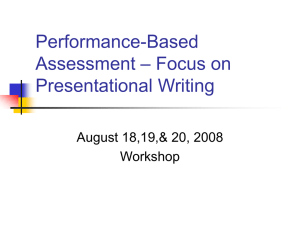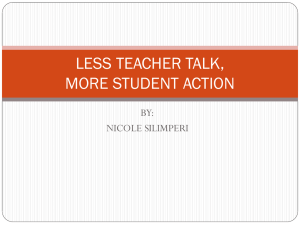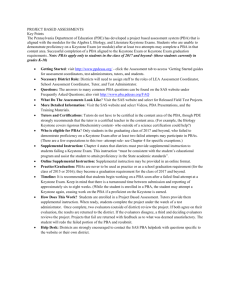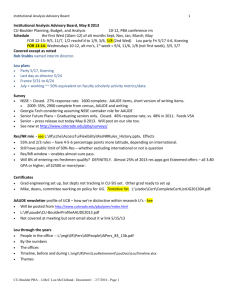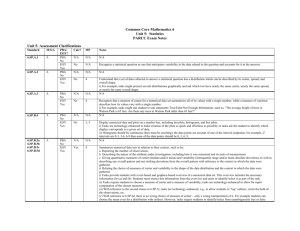Lentil - Agriculture
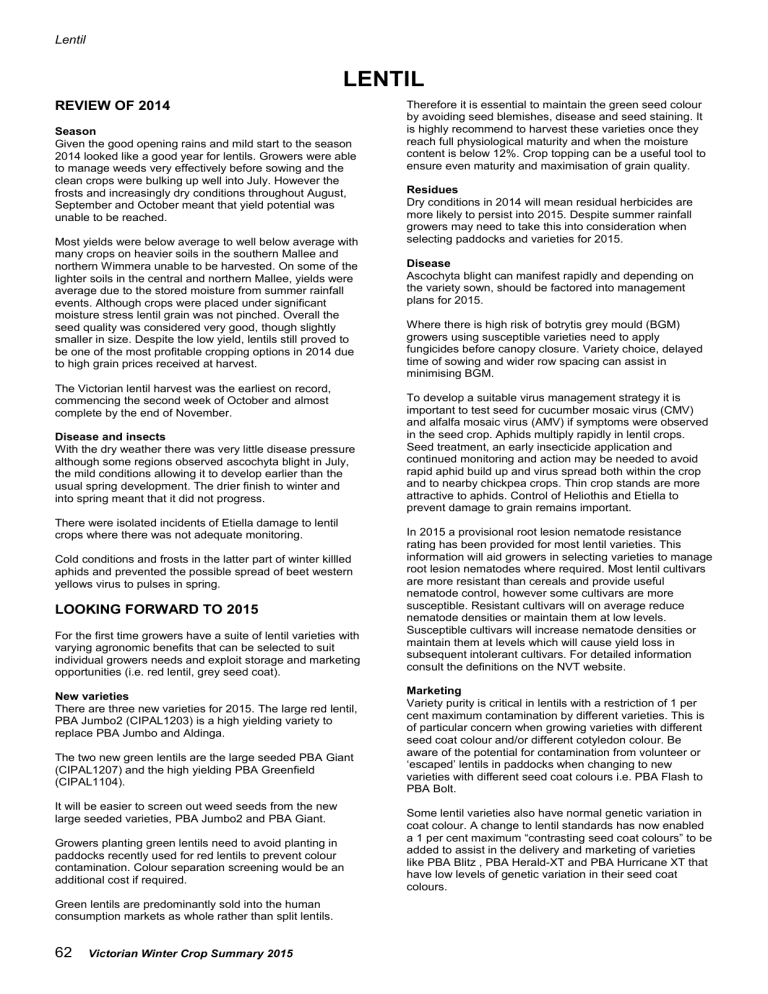
Lentil
REVIEW OF 2014
Season
Given the good opening rains and mild start to the season
2014 looked like a good year for lentils. Growers were able to manage weeds very effectively before sowing and the clean crops were bulking up well into July. However the frosts and increasingly dry conditions throughout August,
September and October meant that yield potential was unable to be reached.
Most yields were below average to well below average with many crops on heavier soils in the southern Mallee and northern Wimmera unable to be harvested. On some of the lighter soils in the central and northern Mallee, yields were average due to the stored moisture from summer rainfall events. Although crops were placed under significant moisture stress lentil grain was not pinched. Overall the seed quality was considered very good, though slightly smaller in size. Despite the low yield, lentils still proved to be one of the most profitable cropping options in 2014 due to high grain prices received at harvest.
The Victorian lentil harvest was the earliest on record, commencing the second week of October and almost complete by the end of November.
Disease and insects
With the dry weather there was very little disease pressure although some regions observed ascochyta blight in July, the mild conditions allowing it to develop earlier than the usual spring development. The drier finish to winter and into spring meant that it did not progress.
There were isolated incidents of Etiella damage to lentil crops where there was not adequate monitoring.
Cold conditions and frosts in the latter part of winter killled aphids and prevented the possible spread of beet western yellows virus to pulses in spring.
LOOKING FORWARD TO 2015
For the first time growers have a suite of lentil varieties with varying agronomic benefits that can be selected to suit individual growers needs and exploit storage and marketing opportunities (i.e. red lentil, grey seed coat).
New varieties
There are three new varieties for 2015. The large red lentil,
PBA Jumbo2 (CIPAL1203) is a high yielding variety to replace PBA Jumbo and Aldinga.
The two new green lentils are the large seeded PBA Giant
(CIPAL1207) and the high yielding PBA Greenfield
(CIPAL1104).
It will be easier to screen out weed seeds from the new large seeded varieties, PBA Jumbo2 and PBA Giant.
Growers planting green lentils need to avoid planting in paddocks recently used for red lentils to prevent colour contamination. Colour separation screening would be an additional cost if required.
Green lentils are predominantly sold into the human consumption markets as whole rather than split lentils.
LENTIL
Therefore it is essential to maintain the green seed colour by avoiding seed blemishes, disease and seed staining. It is highly recommend to harvest these varieties once they reach full physiological maturity and when the moisture content is below 12%. Crop topping can be a useful tool to ensure even maturity and maximisation of grain quality.
Residues
Dry conditions in 2014 will mean residual herbicides are more likely to persist into 2015. Despite summer rainfall growers may need to take this into consideration when selecting paddocks and varieties for 2015.
Disease
Ascochyta blight can manifest rapidly and depending on the variety sown, should be factored into management plans for 2015.
Where there is high risk of botrytis grey mould (BGM) growers using susceptible varieties need to apply fungicides before canopy closure. Variety choice, delayed time of sowing and wider row spacing can assist in minimising BGM.
To develop a suitable virus management strategy it is important to test seed for cucumber mosaic virus (CMV) and alfalfa mosaic virus (AMV) if symptoms were observed in the seed crop. Aphids multiply rapidly in lentil crops.
Seed treatment, an early insecticide application and continued monitoring and action may be needed to avoid rapid aphid build up and virus spread both within the crop and to nearby chickpea crops. Thin crop stands are more attractive to aphids. Control of Heliothis and Etiella to prevent damage to grain remains important.
In 2015 a provisional root lesion nematode resistance rating has been provided for most lentil varieties. This information will aid growers in selecting varieties to manage root lesion nematodes where required. Most lentil cultivars are more resistant than cereals and provide useful nematode control, however some cultivars are more susceptible. Resistant cultivars will on average reduce nematode densities or maintain them at low levels.
Susceptible cultivars will increase nematode densities or maintain them at levels which will cause yield loss in subsequent intolerant cultivars. For detailed information consult the definitions on the NVT website.
Marketing
Variety purity is critical in lentils with a restriction of 1 per cent maximum contamination by different varieties. This is of particular concern when growing varieties with different seed coat colour and/or different cotyledon colour. Be aware of the potential for contamination from volunteer or
‘escaped’ lentils in paddocks when changing to new varieties with different seed coat colours i.e. PBA Flash to
PBA Bolt.
Some lentil varieties also have normal genetic variation in coat colour. A change to lentil standards has now enabled a 1 per cent maximum “contrasting seed coat colours” to be added to assist in the delivery and marketing of varieties like PBA Blitz , PBA Herald-XT and PBA Hurricane XT that have low levels of genetic variation in their seed coat colours.
62
Victorian Winter Crop Summary 2015
MORE INFORMATION
www.nvtonline.com.au
Detailed NVT trial results and links to variety information.
Australian Field Crop Disease Guide app www.extensionaus.com.au/australian-field-cropdisease-guide-app www.depi.vic.gov.au/agriculture-and-food/grains-and-othercrops
Growing lentil
AG1347 Pulse disease guide www.pulseaus.com.au
Pulse Australia information on growing pulses including:
Lentil disease management strategy
VARIETY DESCRIPTIONS
denotes Plant Breeder Rights apply
End Point Royalty (EPR) 2015-16 quoted $/tonne ex-GST.
Red lentil – ALDINGA
Aldinga has medium-large seed with good milling characteristics. Aldinga is MRMS to foliar infection by ascochyta blight but MS to seed infection. It is also MS to
BGM and lodges more than other varieties. It has been a preferred variety for some farmers using no till systems.
Released 1994. AFCA. No market restrictions.
Red lentil – NIPPER
Nipper is similar to Northfield in many characteristics, including relatively short height and seed shape, but it has a grey seed coat. Nipper is MRMS to foliar ascochyta blight, MR to seed ascochyta and R to BGM. It is also R to the exotic disease Fusarium wilt, has improved salinity tolerance and generally lodges less than other varieties.
Nipper is well established in markets, and has attracted a premium price in some years. Released 2005. Seednet.
EPR $5.
Red lentil – NUGGET
Nugget is a mid season variety with a medium size seed and a grey seed coat. It is MRMS to foliar and seed ascochyta blight and BGM. Nugget is not grown much anymore as it has now been superceded by PBA Ace and
PBA Bolt. Released 1999. Heritage Seeds. EPR $5.
Red lentil
– PBA ACE
PBA Ace is a medium sized red lentil with grey seed. A mid-season lentil that has been the highest yielding across all areas, though it can be lower yielding in dry years or high temperatures. PBA Ace is best suited to longer season areas replacing Nugget and PBA Jumbo. It has excellent ascochyta resistance and is MRMS to BGM. It is intolerant to salinity and boron. High milling quality.
Released 2012. PB Seeds. EPR $5.
Red lentil - PBA BLITZ
PBA Blitz is a medium sized red lentil with a grey seed coat that is early flowering and is suited to short growing seasons and environments. It has improved early vigour and an erect growth habit which is suited to no-till and interrow sowing. PBA Blitz is MR to foliar ascochyta and MRMS to seed ascochyta and MR to BGM. PBA Blitz is rated as intolerant of soil boron and salinity. It has demonstrated similar but generally improved milling characteristics compared to Nugget. Released 2010. PB Seeds. EPR $5.
Lentil
Red lentil – PBA BOLT
PBA Bolt is a medium sized red lentil with grey seed.
Adapted to the Mallee and northern Wimmera. While similar to PBA Flash with early-mid maturity and salinity tolerance, it is better in the southern Mallee as it is MR to foliar ascochyta blight and R to seed ascochyta blight. Its susceptibility to BGM makes it less suited to medium-high rainfall areas in wetter years and with early sowing. Like
PBA Flash, PBA Bolt is a good variety for timely crop topping to control weeds. An erect habit and good lodging resistance make it easier to harvest in dry conditions.
Released 2012. PB Seeds. EPR $5.
Red lentil - PBA BOUNTY
PBA Bounty is a high yielding small seeded red lentil that is broadly adapted and suited to most lentil growing environments. PBA Bounty is MRMS to foliar ascochyta blight, MR to seed ascochyta blight and MS to BGM. It has improved tolerance to salinity compared to Nugget. PBA
Bounty has a prostrate plant growth habit early in the season compared with all other varieties. PBA Bounty produces a round seed that is slightly larger (10%) than
Nipper, but still likely to be sold into similar markets for splitting or the production of “footballs” (whole seed with the seed coat removed). Released 2009. PB Seeds. EPR $5.
Red lentil
– PBA FLASH
PBA Flash is an early maturing, high yielding red lentil with a medium seed size and is suited to all current lentil growing areas but particularly shorter season growing areas. It has improved tolerance to boron and salinity compared to Nugget , which along with its height and erectness, has contributed to its popularity in the Mallee.
Like PBA Bolt, PBA Flash is a good variety for timely crop topping to control weeds. It is MS to foliar and seed ascochyta blight. It is MRMS to BGM. PBA Flash has improved standing ability at maturity relative to other lentil varieties which may make it more prone to pod drop in windy environments, timely harvest is required. It is well suited to medium red lentil grain markets, similar to Nugget, particularly for splitting. Released 2009. PB Seeds. EPR
$5.
Red lentil – PBA HERALD XT
PBA Herald XT is a small red seeded lentil best adapted to longer growing seasons with medium to higher rainfall. It was the first lentil with improved tolerance to imazethapyr with an interim permit for pre or post-emergent application to 2017. It has improved tolerance to the herbicide flumetsulam plus reduced sensitivity to some sulfonylurea and imidazolinone herbicide residues. It is important to note that growers must adhere to product label rates, plant back periods and all label directions for use.
PBA Herald XT has been outclassed by the new PBA Hurricane XT. PBA
Herald XT is R to foliar and seed ascochyta and BGM.
Disease resistance will assist in achieving high grain quality. Released 2011. PB Seeds. EPR $5.
Victorian Winter Crop Summary 2015
63
Lentil
Red lentil – PBA HURRICANE XT
PBA Hurricane XT is a small red seeded lentil with mid flowering and maturity. Like PBA Herald XT it has tolerance to imazethapyr with an interim permit for pre or postemergent application to 2017. It has improved tolerance to the herbicide flumetsulam plus reduced sensitivity to some sulfonylurea and imidazolinone herbicide residues. It is important to note that growers must adhere to product label rates, plant back periods and all label directions for use.
PBA Hurricane XT is the highest yielding small red lentil available in Australia and has improved yields over PBA
Herald XT, Nipper and Nugget, but lower than PBA Ace. It is MR to foliar ascochyta, R to seed ascochyta and MRMS to BGM. Released 2013 (CIPAL1101). PB Seeds. EPR $5.
Red lentil – PBA JUMBO
PBA Jumbo is a high yielding large seeded red lentil with a grey seed coat. It is mid flowering with a maturity similar to
Nugget. Suited to no-till inter-row sowing into standing stubble. It is MRMS to foliar ascochyta blight and R to seed ascochyta, but MS to BGM, which may require timely management. Tolerance to soil boron is similar to PBA
Flash. PBA Jumbo is suited to medium to high rainfall regions where it produces uniform larger seed size for the premium large red split markets, but will be outclassed by
PBA Jumbo2. Released 2010. PB Seeds. EPR $5.
Red lentil – PBA JUMBO2
PBA Jumbo2 is the highest yielding large seeded red lentil, approximately 10% higher than PBA Jumbo. It is a direct replacement for Jumbo and Aldinga. It is a similar seed size to Jumbo and Aldinga with a grey seed coat. It is mid flowering and has a maturity similar to PBA Jumbo. It is well suited to no-till inter-row sowing into standing stubble.
It is R to foliar and seed ascochyta blight and BGM .
Tolerance to soil boron is similar to PBA Flash. PBA Jumbo is suited to medium to high rainfall regions where it produces uniform larger seed size well suited to premium large red split markets. Released 2014 (CIPAL1203). PB
Seeds. EPR $5.
Green lentil - BOOMER
Boomer is a large seeded green lentil that is tall, bulky and vigorous but can lodge when growing conditions are favourable. Sowing early can increase lodging and result in smaller seed. Boomer is MR to foliar ascochyta blight, and
MRMS to seed ascochyta blight and BGM. Early harvest is important to prevent shattering and produce good coloured seed. Boomer is expected to be superceded by PBA Giant.
Released 2005. Seednet. EPR $5.
Green lentil – PBA Giant
The largest seeded green lentil in Australia with an average seed diameter of 5.8 mm (approximately 7 g/100 seeds).
PBA Giant is broadly adapted but best-suited to the medium rainfall lentils growing regions. It has similar yield and improved shattering resistance to Boomer, though timely harvest is still required to minimise shattering. It is more susceptible to lodging at maturity than Boomer. It is
MR to foliar ascochyta, and MS to seed ascochyta and
BGM. Released 2014 (CIPAL1207). PB Seeds. EPR $5.
Green lentil – PBA Greenfield
The highest yielding green lentil variety with yields similar to PBA Ace. PBA Geenfield is a medium-sized green lentil broadly adapted but best-suited to the medium rainfall lentils growing regions. With improved tolerance to salinity and resistance to shattering, although timely harvest is still required. It is MRMS to foliar and seed ascochyta and MR to BGM . Released 2014 (CIPAL1104). PB Seeds. EPR $5.
Table 1: Lentil time of sowing guide.
Take variety flowering & maturity status into account when choosing a sowing date. In the Wimmera, the highest yields are from sowing in early May to mid June. However early sowing increases the risk of yield and quality losses from botrytis grey mould and ascochyta blight. Early sowing also increases the likelihood of crop lodging. This table is a guide only and has been compiled from experimental data and observations of the breeder and local departmental agronomists.
MALLEE/Northern WIMMERA April May
Aldinga, Boomer, Nugget, PBA Ace, PBA Bolt, PBA Bounty, PBA
> > X X X <
June
Blitz, PBA Flash, PBA Greenfield, PBA Giant, PBA Hurricane XT,
PBA Jumbo, PBA Jumbo 2
WIMMERA
Aldinga, Boomer, Nipper, Nugget, PBA Ace, PBA Bolt, PBA
Bounty, PBA Blitz, PBA Flash, PBA Greenfield, PBA Giant, PBA
Herald XT, PBA Hurricane XT, PBA Jumbo, PBA Jumbo 2
April
>
May
X X X X
June
X <
>earlier than ideal, X optimum sowing time, < later than ideal but acceptable
64
Victorian Winter Crop Summary 2015
Lentil
Table 2: Lentil variety agronomic guide (may vary with sowing time and location).
Variety
Small red seed
Nipper
PBA Bounty
PBA Herald XT
PBA Hurricane XT
Medium red seed
Nugget
PBA Ace
PBA Blitz
PBA Bolt
PBA Flash
Large red seed
Aldinga
PBA Jumbo
PBA Jumbo2
Medium green lentil
Grain type red red red red red red red red red red red red
Seed coat grey grey grey grey grey grey grey grey green green grey grey
Seed size
(%)*
75-80
90
75
85
100
100
115-120
100
100-110
120
120
120
Flowering time mid/late mid/late mid/late mid mid mid early early/mid early/mid mid mid mid
Maturity mid mid
Lodging
MR
S mid/late MRMS mid mid/late mid early early/mid early/mid mid mid mid
MR
MS
MRMS
MR
R
MR
S
MS
MRMS
Shattering
MR
R
MR
R
R
MRMS
MR
R
MR
MRMS
MR
R
Salinity Boron
MT
MI
I
I
I
I
I
MI
MI
MI
I
I
PBA Greenfield
Large green lentil
Boomer
PBA Giant yellow yellow yellow green green green
130
150
170 mid mid mid mid/late mid/late mid/late
MS
S
MS
MR
S
MRMS
MI
I
I
R = resistant, MR=moderately resistant, MS=moderately susceptible, S=susceptible, VS=very susceptible, I=intolerant, MT= moderately tolerant, MI= moderately intolerant. * ratings relative to Nugget. Can flower and mature relatively earlier if sown early.
I
MI
MI
I
I
I
I
I
I
I
MI
MI
I
MI
MI
Table 3: Disease rating for current lentil varieties.
Disease ratings from Pulse Breeding Australia, January 2015. No variety with a Resistant rating is immune to disease, and fungicide application may be required under severe disease pressure.
Variety Ascochyta blight Ascochyta blight Botrytis grey mould (BGM) P. neglectus P. thornei
Small red seed
Nipper
Foliar Seed/pod
R
(provisional) (provisional)
RMR p MR p
PBA Bounty
PBA Herald XT
MRMS
MRMS
R
MR
MS
R
MS
R MRMS p MR p
PBA Hurricane XT
Medium red seed
Nugget
PBA Ace
PBA Blitz
MR
MRMS
R
MR
R
MRMS
R
MRMS
MRMS
MRMS
MRMS
MR
MRMS
MRMS
MR p p p
MRMS p
MR
MR p p
MR p
MR p
PBA Bolt
PBA Flash
Large red seed
Aldinga
PBA Jumbo
PBA Jumbo2
MR
MS
MRMS
MRMS
R
R
MS
MS
S
R
S
MRMS
MS
MS
R
MR p
MS p
MR p
MS p
MR p
MR p
MR p
MR p
Medium green lentil
PBA Greenfield
Large green lentil
MRMS MRMS MR
Boomer
PBA Giant
MR
MR
MRMS
MS
MRMS
MS p = These ratings are provisional - treat with caution. R = Resistant RMR = Resistant to moderately resistant MR = Moderately resistant MRMS = Moderately resistant to moderately susceptible MS = Moderately susceptible MSS = Moderately susceptible to susceptible S = Susceptible SVS = Susceptible to very susceptible VS = Very susceptible
Victorian Winter Crop Summary 2015
65
Lentil
Table 4: Lentil disease guide.
Disease Organism
Ascochyta blight
Ascochyta lentis
Botrytis grey mould
Botrytis cinerea and
Botrytis fabae
Symptoms
Leaves: small round whitish grey lesions with brown margins.
Lesions contain small black fruiting bodies of the fungus. Lesions can also form on stems causing premature death. Pod infection can ultimately result in dark discolourations on seed.
Leaves: white round lesions/spots without black fruiting bodies as in ascochyta blight.
Stems: Pale brown grey lesions form on stems that are covered with fluffy grey mould. Botrytis grey mould can cause branches to die and cause discoloured and shrivelled seed.
In severe cases large brown patches can form in the crop.
Occurrence
Common in all lentil growing regions in southern Australia. All varieties except
Northfield and Nipper are at risk of seed infection by ascochyta blight.
Damage is most likely in wet seasons.
Most likely to occur in dense, lodged crops when there is frequent rain late in spring.
VIRUS DISEASES
AMV Alfalfa mosaic virus
Tip necrosis. Young leaves are pale green, small, twisted and distorted.
A faint mosaic pattern may appear.
Prevalent in lentil production regions with high aphid numbers
CMV
BWYV
Cucumber mosaic virus
Yellowing, stunting. Young leaves are pale green, small, twisted and distorted. A faint mosaic pattern may appear.
Beet western yellows virus
Yellowing, stunting. Produces the most severe symptoms of the all the viruses. Patches of crop resemble root disease or herbicide residue damage.
Common in all lentil growing areas with high aphid numbers
Present in all lentil production areas with high aphid numbers.
Hosts
Lentils – seed, stubble and self sown plants.
Most legumes including chickpeas, faba bean and vetch.
Wide host range including most pulses, some horticultural plants and weeds
Wide host range including most pulses, some horticultural plants and weeds
Wide host range including most pulses, some horticultural plants and weeds
Control
Fungicidal seed dressings.
Resistant varieties.
Foliar fungicides.
Crop rotation.
Avoid early sowing.
Fungicidal seed dressings.
Low plant density.
Avoid early sowing.
Foliar fungicides.
Crop rotation.
Resistant varieties.
Virus free seed, management of weeds, resistant varieties.
Virus free seed, management of weeds, resistant varieties.
Managing weeds and aphids, resistant varieties.
Table 5: Long term predicted lentil yield 2010-2014 expressed as a percentage of the yield of Nugget. The numbers in brackets indicate the number of site years in that area.
Nugget (t/ha)
Aldinga
Boomer
Digger
Nipper
Northfield
Nugget
PBA Ace
PBA Blitz
PBA Bolt
PBA Bounty
PBA Flash
PBA Giant
PBA Greenfield
PBA Herald XT
PBA Hurricane XT
PBA Jumbo
PBA Jumbo2
Mallee
1.18
89 (7)
84 (12)
86 (6)
86 (21)
89 (7)
100 (21)
121 (21)
87 (21)
115 (21)
106 (12)
97 (21)
99 (3)
113 (8)
91 (21)
113 (19)
92 (21)
121 (14)
Wimmera
1.90
92 (7)
92 (14)
91 (5)
93 (16)
85 (9)
100 (16)
110 (16)
93 (16)
108 (16)
104 (13)
99 (16)
96 (7)
105 (11)
92 (16)
108 (14)
102 (16)
113 (11)
66
Victorian Winter Crop Summary 2015
Lentil
Table 6: Yield of lentil expressed as a percentage of the yield of Nugget and grain weight (g/100 seeds) in
2014 NVT and Vic DEPI (B) trials.
Yield (%) Grain weight (g/100 seeds)
Sowing Date
Nugget (t/ha)
Boomer
Mallee
Rainbow
(F)
Ultima
(F)
17/5/14
0.88
13/5/14
0.95
Wimmera
Horsham
(B)
Tarranyurk
(F)
3/6/14
2.19
4/6/14
0.5
Nipper
Northfield
Nugget
PBA Ace
PBA Blitz
PBA Bolt
PBA Bounty
PBA Flash
PBA Giant
PBA Greenfield
PBA Herald XT
PBA Hurricane XT
-
81
-
100
118
94
126
-
109
-
-
86
110
-
84
-
100
120
92
109
-
98
-
-
81
102
84
81
82
100
100
96
112
105
105
95
91
85
100
62
76
-
100
94
64
70
-
86
64
86
110
138
PBA Jumbo
PBA Jumbo2
Site Mean (t/ha)
CV (%)
LSD (%)
72
110
0.92
9
15
77
116
0.95
8
13
103
94
2.21
8
14
92
98
0.48
13
22
B = Breeding trials, F = Multiple frosts, at Tarranyurk frost has likely affected PBA Bolt.
Rainbow Ultima Tarranyurk
- - 6.29
3.27
-
3.76
4.20
4.79
4.28
-
4.67
-
-
3.03
3.34
4.59
4.86
Mallee
3.41
-
4.11
4.34
5.44
4.30
-
4.94
-
-
3.15
3.50
5.04
4.85
Wimmera
3.47
-
4.27
4.63
5.28
4.72
-
5.08
6.41
5.31
3.02
3.46
5.54
5.52
ACKNOWLEDGEMENTS
Jason Brand
Matthew Rodda
Frank Henry
Josh Fanning
Mary Raynes
Department of Economic Development, Jobs, Transport and Resources, Horsham
Department of Economic Development, Jobs, Transport and Resources, Horsham
Department of Economic Development, Jobs, Transport and Resources, Hamilton
Department of Economic Development, Jobs, Transport and Resources, Horsham
Pulse Australia
Victorian Winter Crop Summary 2015
67
